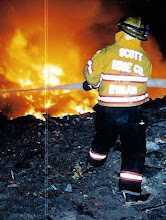Mom was not a fan of lights on the roof of cars. She felt they detracted from the looks. Further, she didn’t even like them on the
front dash, arguing they obstructed her vision.
None of this was much of an issue when Dad was a
firefighter, lieutenant, or captain. We
lived less than a mile from the station; one stop sign and two turns away. When he made Assistant Chief and had to start
responding to the scene, things changed.
A mobile radio—with tubes—was installed in the car. A miniature manual siren was bolted under the
hood. Neither of these was a problem; it
was the red light that was in dispute.
Locating it on the roof was out of the question and her objections
regarding the front dash were continued.
The l ight ended up on the rear deck in the back window of the old
Dodge.
This location was one step above useless. When parked at a scene, it could be useful,
but did little to expedite actually getting there.
All this changed one fortuitous day when Mom and I happened
to be in the car with Dad when a fire call was received. Dad called out as responding and activated
the light on the rear deck and the dinky siren, and attempted to weave his way
through what passed as traffic in our little town. In the front seat, Mom was astounded at the
difficulty he experienced.
“Why won’t these people pull over?” She asked, incredulous over
this lack of cooperation, her hands braced o the dash board against the bobbing
and weaving of the car.
“Because nobody can see the damn light,” Dad said. Mom knew better than to continue the
conversation while we were enroute to the call.
Meanwhile, I was having a blast in the back seat; seeing the flashes of
red bounce in and out of the car and looking for smoke in the sky in front of
us.
Mom and I watched from the car while the incident, nothing
serious if memory serves, was handled.
When the fire apparatus was repacked and returning to the station, Dad
got back in the car. Mom had apparently
been giving some thought to the ride we took to the scene and her previous
position on the location of the red light in the car. Before Dad had barely settled in to start the
ignition, she revealed her decision.
“Rich, put the damn light wherever you want it.”
Dad didn’t say anything, but before the day was out, the
center of the roof was graced with the old single bulb red light.









